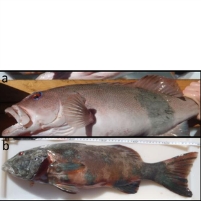Fish Get Skin Cancer from Sun Under Ozone Hole
Sunday, August 05, 2012
 Fish with lesions (photo-M. Sweet et al. (2012) Evidence of Melanoma in Wild Marine Fish Populations. PLoS ONE 7(8): e41989)
Fish with lesions (photo-M. Sweet et al. (2012) Evidence of Melanoma in Wild Marine Fish Populations. PLoS ONE 7(8): e41989)
Australia, already the skin cancer capital of the world, is now the first place where fish are known to get the deadly disease as well. The Land Down Under sits under the planet’s largest hole in the ozone layer, a stratum of the atmosphere that absorbs 97% to 99% of the sun’s medium-frequency ultraviolet light, or UV rays, which would otherwise cause skin cancers and other diseases. Scientists believe that the Australian ozone hole is responsible for the fact that two out of three Australians will be diagnosed with skin cancer by the age of 70, the highest rate in the world.
As so often happens in science, researchers made their discovery quite by accident. Scientists from the Australian Institute of Marine Science were conducting a survey near the Great Barrier Reef of shark prey, mainly coral trout. Noticing odd dark patches on the usually bright orange fish, they asked for help from a University of Newcastle (U.K.) research team that was studying coral disease.
After eliminating infectious diseases as the cause, scientists determined that the black skin lesions were a form of melanoma — the most dangerous and deadly type of skin cancer. Although scientists have not yet definitively determined that these piscine skin cancers are caused by the ozone hole, they strongly suspect that is the case. Their suspicions are bolstered by the fact that local fisherman report that they’ve been seeing the black spots on coral trout since the 1980s, around the same time that scientists began noticing the depletion of atmospheric ozone and the formation of the ozone hole over Antarctica and Australia.
The researchers found that of 136 coral trout studied, 15% showed dark lesions on the skin, ranging from covering as little as 5% of the skin to nearly 100%. They expect further study will show even higher rates of cancer, as sicker fish were less likely to be caught in their initial sample. As study lead author Michael Sweet says, “The findings are strongly linked to UV and it’s too much of a coincidence for it not to be linked to the hole in the ozone layer.”
-Matt Bewig
Fish Getting Skin Cancer from UV Radiation, Scientists Say (by Jon Bardin, Los Angeles Times)
Evidence of Melanoma in Wild Marine Fish Populations (by Michael Sweet et al., Public Library of Science)
Fish with Skin Cancer Discovered for First Time (by Tom White, The Independent)
- Top Stories
- Unusual News
- Where is the Money Going?
- Controversies
- U.S. and the World
- Appointments and Resignations
- Latest News
- Trump Goes on Renaming Frenzy
- Trump Deports JD Vance and His Wife
- Trump Offers to Return Alaska to Russia
- Musk and Trump Fire Members of Congress
- Trump Calls for Violent Street Demonstrations Against Himself






Comments